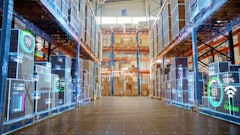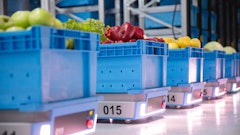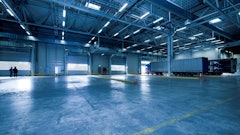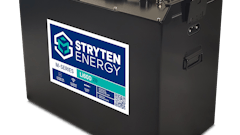
Grocery retailers and food distributors are finally catching up with the rest of the food industry in the use of automation in their warehouses.
Despite the hefty price tags of the solutions, these companies are employing a variety of automated and semi-automated storage retrieval systems (AS/RS)—including horizontal and vertical carousels, stacker cranes, conveying and sortation systems and automated guided vehicles—throughout their facilities.
In recent years, a number of grocers and distributors such as The Kroger Co., C&S Wholesale Grocers, Sobey’s, HEB and Stop ‘n Shop have gone high-tech in their warehouses—and experts expect that trend to continue. Faced with the increasing complexity of receiving, storing, picking and shipping product, many are looking for new ways to improve logistics performance levels at a lower cost, according to Ken Ruehrdanz, warehousing and distribution market manager for Dematic Corp., Grand Rapids, MI, which leads them to automation.
“The drivers in food distribution include SKU proliferation, servicing multi-format retailing, building mixed case pallets, space utilization, transportation costs, inventory and order accuracy and labor costs, as well as health and safety issues for employees,” says Ruehrdanz.
According to the Material Handling Industry of America (MHIA), sales of automation equipment reached a record low last year. However, because the recession did not hit the food industry as hard as it did others, food companies did not put the brakes on automation investments. Vendors report seeing a growing number of new projects, retrofits and system upgrades for their food as well as beverage customers.
The good news for grocery distributors is that a number of automation solutions providers are targeting the industry. “This is where the real arms race is in terms of automation for material handling—it’s all focused on food and beverage right now,” says Tom Coyne, president and CEO of System Logistics Corp., Lewiston, ME. “And in the grocery space, there have been a couple of companies that have been willing to make the long term investment and take the risk.”
“There’s been a huge increase in the interest in automation across the board in the industry—from the food and beverage manufacturers and distributors to the retailers,” agrees Paul Moore, director of MS systems sales of Mason, OH-based Intelligrated Inc. “One of the big drivers is the consolidation of the industry—it’s creating scale. In grocery, you’ve got retail giants such as Walmart and Target, in beverage you’ve got Anheuser-Busch and we’re seeing a lot of acquisitions in the snack food arena. The larger these companies get, the more automation makes sense for them. Their size helps them get a good return on investment on these types of solutions.”
Another big driver is the need for store friendly deliveries, according to Dematic’s Ruehrdanz.
“The traditional method was to replenish the store once or twice a week, with the inventories being stored in the backroom of the store. As consumers purchased items, the stores would replenish the items from the backroom and invariably stock outs would occur,” says Ruehrdanz. “As companies strive to reduce stock-outs within stores, there is a focus on smaller, more frequent replenishments from the DC to the store. With this strategy, rather than replenish the backroom, the received shipment is replenished directly to the store shelf.”
Advances in automated case picking is also driving the trend, say the experts. “Retailers are looking for systems that can automatically pick cases and palletize cases in aisle sequence at the distribution center for store friendly delivery, allowing quick replenishment on the shelf,” says Sean O’Farrell, business development manager for Witron, Arlington Heights, IL. “Besides the obvious savings within the warehouse, many of our retail customers point out that automation is also saving labor in their stores. This is a direct result of our ability to automatically build store-friendly and aisle-ready mixed SKU pallets within the warehouse.”
Automating The Case Picking Process
Order picking is the most costly function in a warehouse and in the food industry—thanks to SKU proliferation and the need for smaller, more frequent deliveries—case picking volumes and costs as percent of total DC expenses are going up. To combat this problem, a number of material handling vendors have developed technologies to automate or semi-automate the case picking process. These solutions offer improvements in productivity, accuracy and speed of delivery.
“Full case picking used to be considered the Holy Grail of distribution,” says Jack Lehr, vice president sales, automation, Schaefer Systems International Inc., Charlotte, NC. “Until just a few years ago, there were no good solutions—nothing cost justifiable and reliable.”
Schaefer designed its case picking system (SCP) for high-SKU environments such as grocery and beverage handling. The SCP automates all processes from receiving, de-palletizing, selecting, sequencing and palletizing of mixed case pallet loads. The system can handle from 30,000 to 300,000 cases per day and by removing labor from the process, users can expect to attain a drop in cost-per-unit shipped by up to 30 percent.
The system uses advanced computer simulation of pallet-load building. The software that controls the order-picking and sequencing system starts with order information and then virtually builds cube-optimized pallets. Then the software tells the system which trays and in what order to deliver to the pick system. Palletizing robots receive the products in the correct sequence, allowing the SCP to build cube-optimized, store-ready pallets by family group.
Product characteristics are entered into the system through Schaefer’s cube dimensioning unit that collects and stores physical data. “The software that drives the SCP is very complex, so if you’re going to automate a DC specifically for case picking, you need a good IT staff because they’ve got to understand how the software works,” says Lehr. “Although there’s a significant savings in manual labor, companies always have to increase the size of their engineering and IT departments. One of our clients is going from 218 warehouse employees to 23. But they’re going to hire 13 engineers, because they’re running a triple shift operation and you’ve got to have adequate coverage on every shift.”
Besides the obvious labor savings within the warehouse, many retailers point out that automation is also saving labor within the stores, notes Witron’s O’Farrell. “This is a direct result of our ability to automatically build store-ready and aisle-ready mixed SKU pallets within the warehouse.”
Witron has developed automated case-picking systems for supermarket chains such as Kroger and Sobey’s that enables the retailers to build mixed pallets for individual stores. Witron’s OPM (order picking machinery) system loads cases onto the pallets in the sequence that they’ll be put away on the shelves in the store.
Last year, Sobey’s opened a fully-automated 500,000-square-foot DC in Vaughan, Ontario, to service more than 340 stores in the Toronto area. The facility receives more than 320,000 cases per day and can ship 200,000 cases per day. The majority of the case picking is done by the OPM system. Order pallets are automatically assembled by 16 picking machines that are installed on two-levels within the warehouse. The retailer says that having the pallets automatically assembled by the individual store layouts has reduced product damage and labor at store, and the system has enabled it to have near perfect order accuracy while helping to reduce out-of-stocks.
The benefits extend beyond the warehouse and store as well. “Automation is also helping our customers realize savings in transportation, as our automated case picking system can produce taller and denser order pallets than conventional picking methods,” says O’Farrell. “One customer experienced an 8 percent reduction in transportation cost after implementing our automated case picking system.”
AGVs—An Affordable Alternative To Lift Trucks
For many companies, a full-blown AS/RS implementation is financially out of the question—and, in fact, may not even be necessary. Material handling vendors offer a variety of affordable point solutions that can work within an existing warehouse.
For example, the lift truck is the mainstay of the conventional warehouse. Most fundamental activities in the facility, however, can be carried out by automated guided vehicles (AGVs)—eliminating the need for manual lift trucks, according to Mike Kotecki, senior vice president of HK Systems Inc., New Berlin, WI. AGVs automatically move material through a facility without an onboard operator or driver. They have defined paths over which they can navigate. The paths are defined by buried inductive wires, surface mounted magnetic or optical strips, or by laser guidance.
“AGVs were primarily used for transportation, but we’ve extended the reach of an AGV to be comparable to a VNA (very narrow aisle) truck or a small AS/RS,” says Kotecki. “These same vehicles can now do storage and retrieval in racking systems and can conform to a variety of facility types and applications.”
HK recently introduced its “Automate the Conventional” automated solution for conventional warehouses. Designed to lower operating costs, increase inventory accuracy and reduce product and facility damage, the solution replaces list trucks with HK’s fork style AGVs.
One of the greatest advantages of an AGV system, says Kotecki, is that a company can address several challenges without the need to reconfigure conventional rack storage areas. “You don’t have to move the rack or make the ceiling any higher. It’s all retrofittable automation, at the fraction of the price of an AS/RS.”
AGVs can conform to a variety of facility types and applications, every type of pallet movement within a warehouse or distribution center, and store and retrieve in a narrow aisle storage and VNA storage warehouse. AGVs have a number of advantages over lift trucks, including labor savings, reduced product and facility damage, increased productivity and inventory accuracy.
AGVs can also enhance voice picking operations, according to Stuart Edwards, manager, food distribution market, Dematic. “AGVs complement the picking process. With conventional pick to pallet operations, the picker drives the pallet jack to the various pick locations. On completion of the order, the picker moves the completed order pallet to the shipping dock. This leaves inefficiencies due to having a small distance between pick locations because (picker will need to board and alight the pallet jack) and moving the pallet to the shipping dock—all these activities detract from picking productivity.
“The AGV system automatically moves to the correct picking location and moves the completed pallet to the shipping dock without the picker, thereby allowing them to continue picking operations,” says Edwards.
Another example is a semi-automated configuration for accommodating slow-moving inventory. “It includes an AS/RS for staging food products,” says Edwards. “The AS/RS replenishes the pick faces located on the first level. Operators on the outside of the rack pick to pallet from the pick faces. This method reduces the system footprint (eight to one, typically), increases picking productivity since the pick path distance is typically reduced by 75 percent and the replenishment process is fully automated, thereby eliminating labor cost for this function.”
Insourcing Vs. Outsourcing
For companies that outsource their warehousing and transportation operations, automation provides an opportunity to bring those functions in house—and gain better control of their supply chain. “We’re asking manufacturers to reconsider the trade-offs, long term, to insourcing vs. third-party logistics providers,” says Bill Leber, business development manager for Swisslog, Newport News, VA. “Manufacturers that are outsourcing are losing a bit of control and connection down the supply chain.”
Leber points to manufacturers that are consolidating their networks, such as PepsiCo, which recently acquired its bottlers. “It wasn’t that they were having issues with getting stuff in the bottle—it’s about getting control of the distribution network. And automation will allow them to get more out of their facilities. The start up costs are high, but with automation you can maximize the use and productivity of the facility—put on a second shift or run it 24/7,” he says.
On the other hand, HK Systems has launched a company called HK Logistics that not only develops automated material handling systems, but owns and operates them as a 3PL. “If a food manufacturer wanted to have a 40-aisle AS/RS system with lights out operation and robotic palletizing—but didn’t want to own it—we would build it, staff it and provide them with service custom-made for their business,” says Kotecki. “It’s a pretty revolutionary concept.”
Designing an automated or semi-automated system is contingent on a company’s product mix and throughput rates, so companies need to do a through analysis of their operation to determine if they’re a good candidate for automation.
“Automation can be scaled or tailored to meet the needs of the business,” says Coyne of System Logistics. “If you’re shipping 1,000 cases per hour out the door, you’re probably not a candidate for robots, but you may be a candidate for lower cost technology that can improve your picking performance. If you’re hitting rates of 4,000 to 5,000 cases per hour and you’re carrying more than 500 SKUs, you might be a candidate for a higher level of automation.”
The food industry is destined to see more automation in its distribution process, adds Coyne. “It has the highest velocity rate of the overall American supply chain, so it’s destined to be automated to a higher degree. It’s just a question of how fast it’s going to happen and what’s the final evolution of the solution going to be.”
VENDOR LISTING
• Daifuku America Corp., Salt Lake City, UT;
www.daifukuamerica.com
• Dematic Corp., Grand Rapids, MI; www.dematic.us
• HK Systems Inc., New Berlin, WI; www.hksystems.com
• Intelligrated Inc., Mason, OH; www.intelligrated.com
(acquired FKI Logistex Group)
• Retrotech Inc., Fishers, NY; www.retrotech.com
• Schaefer Systems International Inc., Charlotte, NC;
www.ssi-schaefer.us
• Swisslog Logistics Inc., Newport, MI; www.swisslog.com
• System Logistics Corp., Lewiston, ME;
www.systemlogistics.com (acquired Diamond Phoenix)
• TGW-Ermanco Inc., Spring Lake, MI; www.tgw-ermanco.com
• viastore systems Inc., Grand Rapids, MI; www.us.viastore.com
• Westfalia Technologies Inc., York, PA; www.westfaliausa.com
• Witron, Arlington Heights, IL; www.witron.com
FIVE REASONS TO AUTOMATE
Automation can be utilized in varying degrees to achieve improvements in product flow, labor allocation, facility size and overall operating costs, according to Ken Ruehrdanz, warehousing and distribution market manager, for Dematic Corp., Grand Rapids, MI.
“Items to analyze and consider in the current operation include: number of ‘touches’ by workers, bio-mechanical injuries, issues with seasonal labor, order accuracy, order processing speed and complexity of building mixed case pallets for customer orders,” says Ruehrdanz.
Here are some of the benefits that can be achieved through automation.
Reduction in bio-mechanical injuries: “Food distribution centers primarily handle case goods, which tend to be heavy—especially when a worker handles these case loads for an entire shift of an operation. Workers will bend, lift and twist a hundred times a day while handling cases of product. Injuries can be devastating to the health of workers, not to mention medical and absentee costs,” says Ruenhrdanz.
Also, the turnover rate in these job functions can be very high. AS/RS can accommodate cases and pallets automatically, thus allowing fewer “touches” by human hands.
Reduce exposure to harsh working environments: Freezer storage often requires that product be held in sub-zero temperatures. “This environment is not ideal for worker comfort and health. Legal restrictions require that workers can only be exposed to a freezer environment for limited periods of time, thus increasing costs—turnover rate is also high in these job categories. Automation for the warehouse storage function allows staff to work outside the freezer or cooler environment,” says Ruenhrdanz.
Reduction in building and energy costs: Freezer and cooler space is costly to build and maintain; the use of automated systems can minimize freezer/cooler space. For example, the implementation of an ASRS allows high density storage and will therefore reduce the footprint and square footage of the freezer or cooler, thus reducing building costs and energy costs.
“With automation systems, customers can minimize their energy costs. AS/RS technology does not require heating/cooling or a lighted environment to function. Modern conveyor systems have power saving functions that automatically power down if not required,” says Ruenhrdanz.
Improved inventory control and accuracy: For food producers and manufacturers, it is extremely important to make sure first-in first-out strategies are maintained. When compared to traditional methods (rack and manually operated fork lift trucks), the automated systems operate under computer control and therefore product does not get misplaced in the warehouse and first-in first-out strategies are assured.
With the recent food recalls, particularly in fresh prepared foods, it’s even more critical to have robust tracking from manufacturers to the consumers. Automation offers this level of tracking and traceability within the supply chain.
Reduced fork truck fleet and labor: “AS/RS allow less staff to be required to perform the work. When an automated system is utilized in two or three shift operations, significant ROI can be realized. Furthermore, automated systems mean reduction in facility damage by manually operated fork lift trucks and the reduction in product damage,” says Ruenhrdanz.


























